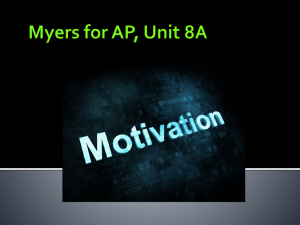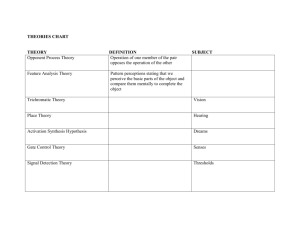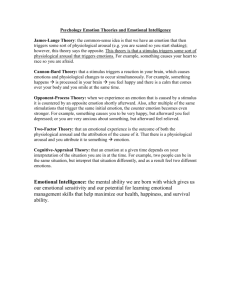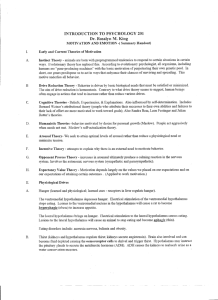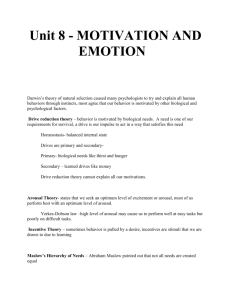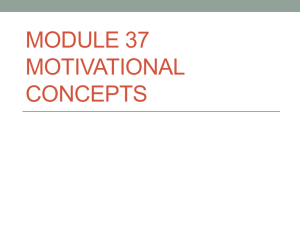Motivation and Emotion
advertisement
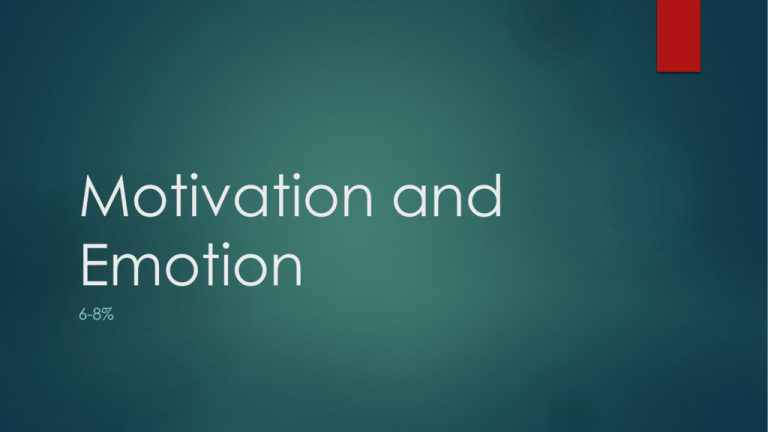
Motivation and Emotion 6-8% Mid-Point Assessment Tabulate your data for the first 7 sections (Perspectives- Cognition) Complete the midpoint assessment and plan Menu of Available Options for question 6 Module Reading Review Guides 500 questions book section Unit review guides (from Barron’s) Unit review guides (from 5 Steps to a 5) Motivation What is motivation? Motivation – a need or desire that energizes and directs behavior; a force that moves people to perform a behavior Instinct Theory/ Evolutionary Psychology Reliant on the idea of instinct- a fixed action pattern that is set off by a sign stimulus (something in the environment that sets the pattern of behavior into motion) Does not adequately describe complex human behavior Genetics can predispose us to species-typical behavior Drive Reduction Theory Physiological need creates an aroused state that drives the organism to reduce the need by some behavior The physiological aim is to restore homeostasisthe natural balanced internal state of an organisms Incentives While we are pushed by drives, we are also pulled by incentives: positive or negative stimuli from our environment For this reason, drive-reduction theory cannot explain all human behavior completely Optimal Arousal Theory States that when all our needs are met we become bored, so some behaviors occur because they increase arousal (mental alertness and excitement) Too much stimulation causes stress, then we look for ways to decrease arousal Yerkes-Dodson Law The principal that performance increases with arousal only up to a point, beyond which performance decreases New research also suggests that performance level depends not only on arousal but also difficulty of task Hierarchy of Needs Abraham Maslow Some needs take priority over others, and only when lower more basic needs are met can we be motivated to focus on higher level needs Self-Actualization and SelfTranscendence The highest and most elusive of Maslow’s needs Self-Actualization: The motivation to develop to one’s full potential as a human being Self-Transcendence: needs to find meaning and identity beyond the self (spiritual) Self-Determination Theory Three basic needs: competence, relatedness, and autonomy No deficit must be present- not drive reduction These needs concern personal growth Competency: two components Self-efficacy- the belief that you have ability to accomplish a given goal or task Mastery- the sense that you can gain skills to over come obstacles This area relates directly to achievement motivation Relatedness The need to engage in warm relations with other people Some psychologists would argue this is the most important human need Supported by research that when people are excluded they tend to engage in a variety of selfdefeating behaviors Autonomy The sense that we are in control of our own life; we have the ability to choose our fate Intrinsic vs. Extrinsic Motivation Intrinsic motivation is based on internal factors and needs (competence, relatedness, and autonomy) Extrinsic motivation is based on external incentives (rewards and punishment) Research shows that intrinsic motivation is the key to achievement A story of motivation… While you watch the story, take notes on things that fall within each of the theories of motivation. Instinct theory/ evolutionary psychology Drive-reduction theory Optimal-arousal Maslow’s theory hierarchy of needs Self-determination theory Analysis of Aaron Ralston’s Motivation https://www.youtube.com/watch?v=ObPb01zGYRA https://www.youtube.com/watch?v=hirhsWXRazs https://www.youtube.com/watch?v=xkGHN-8s5yw https://www.youtube.com/watch?v=lM8x79kIsEA https://www.youtube.com/watch?v=fIgwm2Lq4Q4 https://www.youtube.com/watch?v=dn9Fxw8MAlg Although he finds it difficult and not much fun, Thomas puts in long hours practicing field hockey in the hope of getting an athletic scholarship to college. This best illustrates the idea of A) Homeostasis B) Attribution theory C) Extrinsic motivation D) Arousal theory Hunger Motivation Physiology Your hypothalamus is responsible for monitoring: Blood glucose levels Ghrelin levels- hormone secreted into the blood by an empty stomach Lateral LH hypothalamus stimulates eating (gives one LARGE HUNGER) Ventromedial VMH hypothalamus reduces hunger (gives on VERY MINUTE HUNGER) Appetite Hormones Hormone Action Ghrelin Secreted by empty stomach; sends “I’m hungry” signal to the hypothalamus Hunger stimulating hormone released from hypothalamus to the brain Orexin Insulin Secreted by the pancreases when glucose levels are high; converts glucose to glycogen for storage in the liver Glucagon “when Secreted by pancreases when glucose levels are high; the glucose is gone” converts glycogen into glucose Leptin PYY Protein hormone secreted by fat cells; when abundant causes brain to increase metabolism and decrease hunger Secreted by digestive tract; sends “not hungry” signal to the hypothalamus Physiological Weight Management Set Point- the point at which an individual’s “weight thermostat” is set; determined by genetics and current weight If the body falls below this weight, an increase in hunger and a lowered metabolic rate strive to restore the lost weight If the body rises above this weight, an decrease in hunger and a higher metabolic rate strive to burn excess calories Slow sustained changes in body weight can alter an individuals set point Evolutionary Psychology Carbohydrates boost the levels of serotonin which has a calming effect and makes us happy. Preferences for sweet and salty are genetic and universal buy conditioning can intensity those preferences. Environment can influence the human genetics that affect taste and diet. (lactose, spicy) Pregnant women’s food dislikes peak at the tenth week when the developing embryo is susceptible to toxins. Environmental Psychology Culture teaches us that some foods are acceptable and some foods are not. We eat more when we are with others. When offered the option of larger portions, we choose the largest one. Food variety stimulates overeating. Emotion Autonomic Nervous System Arousal Heightened sense of activation throughout the body Caused by the sympathetic nervous system Not always fight-or-flight, also occurs on a low level when we feel intense emotion (fear, anger, happiness) Theories of Emotion Theory Name/People Approach Example/Anal ysis For our analysis… Biological Theories of Emotion James-Lang Theory (William James and Carl Lange) Stimulus from environment causes physiological change Physiological change causes emotion Each emotion is associated with a specific physiological change Cannon-Bard Theory (Walter Cannon and Philip Bard) Physiological change and emotion occurs simultaneously Cognitive Theory of Emotion Two-Factor Theory of Emotion (Stanley Schechter and Jerome Singer) Emotion is determined by two factors: physiological arousal and cognitive labeling We look at the world for clues to why we are in a state of arousal We interpret external cues and label the emotion Behavioral Theory of Emotion Facial Feedback Hypothesis Facial expressions can influence emotions as well as reflect them Supports the James-Lange Theory Example: we smile because we are happy, but we are also happy because we smile Paul Ekman and Emotion http://www.youtube.com/watch?v=PFqzYoKkCc Sociocultural Factors in Emotion Emotions we can recognize on the faces of others Happiness, sadness, anger, surprise, disgust, and fear This happens almost universally Display Rules- when it is appropriate to show emotion, can vary by culture
